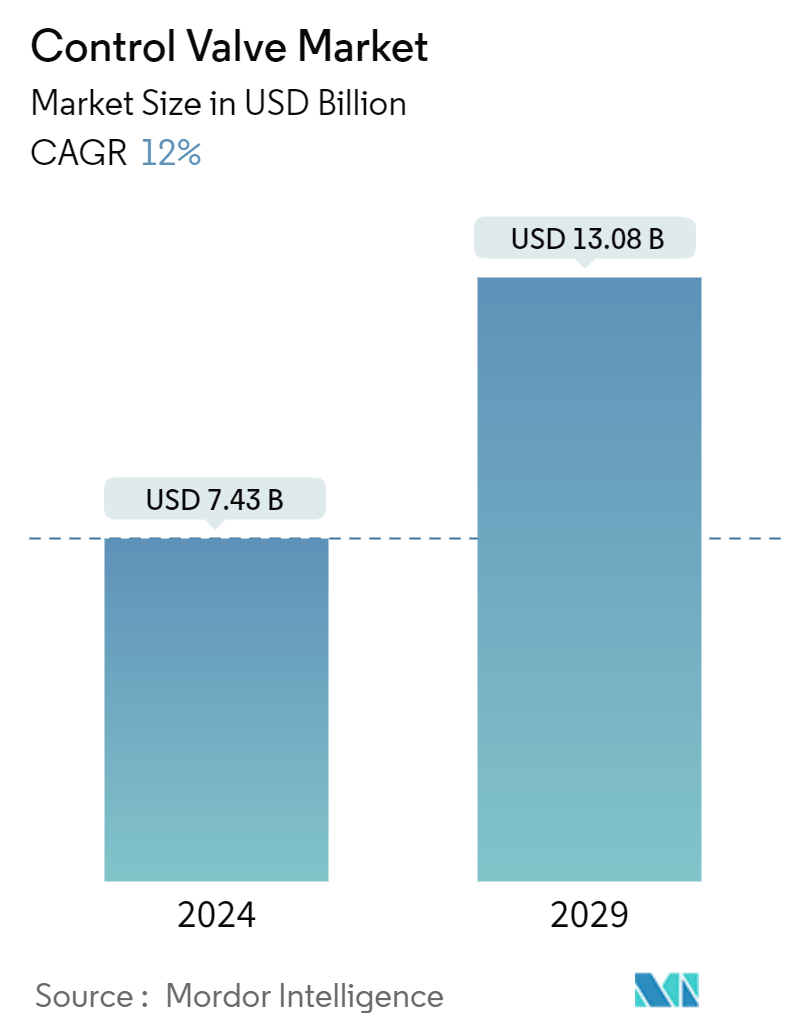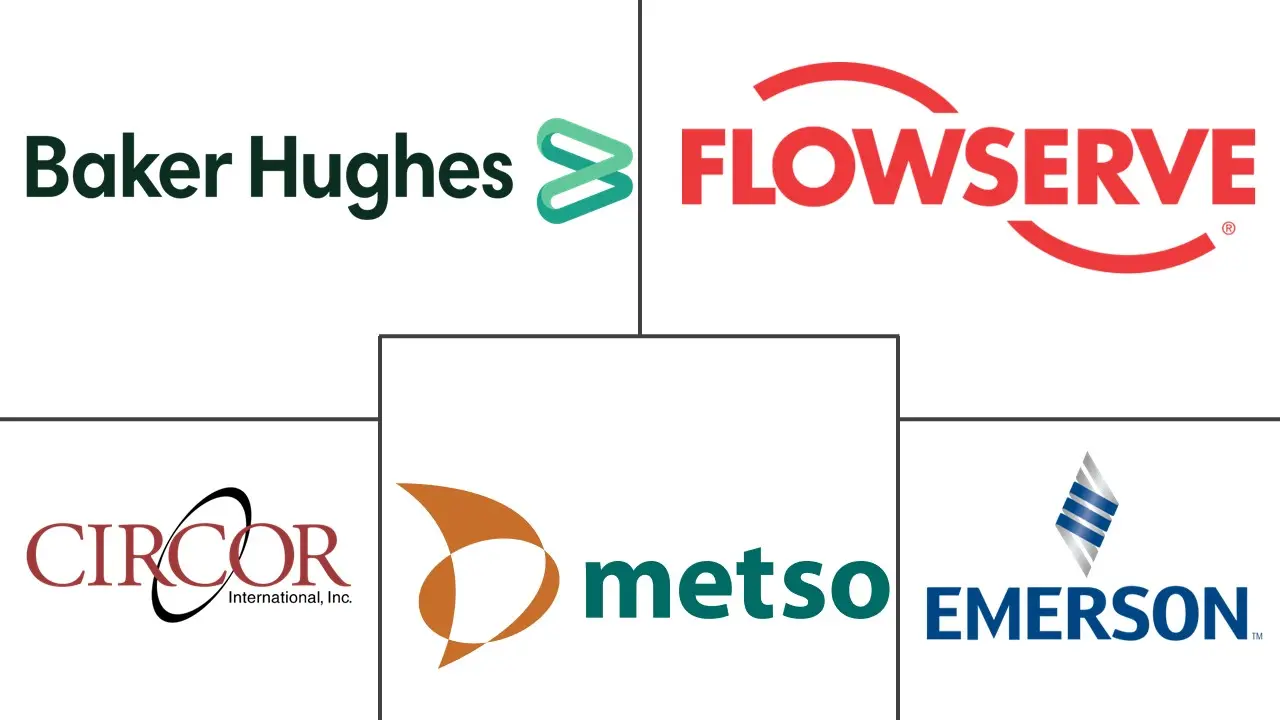Market Size of Control Valve Industry

| Study Period | 2019 - 2029 |
| Market Size (2024) | USD 7.43 Billion |
| Market Size (2029) | USD 13.08 Billion |
| CAGR (2024 - 2029) | 12.00 % |
| Fastest Growing Market | Asia Pacific |
| Largest Market | North America |
| Market Concentration | Medium |
Major Players
*Disclaimer: Major Players sorted in no particular order |
Control Valve Market Analysis
The Control Valve Market size is estimated at USD 7.43 billion in 2024, and is expected to reach USD 13.08 billion by 2029, growing at a CAGR of 12% during the forecast period (2024-2029).
Over the forecast period, increasing investments in pipeline and infrastructure expansion and the increasing adoption of automation across several industries are expected to boost the demand for control valves.
- A control valve is a device utilized to regulate fluid flow by adjusting the size of the flow passage in response to a signal from a controller. This facilitates the precise flow rate management and subsequent regulation of process variables such as pressure, temperature, and liquid level, which are crucial in industries such as oil and gas, water management, power generation, food and beverages, and automotive. Typically, two control valves, linear and rotary, are employed in various industries, offering superior efficiency and safety.
- A control valve can be operated through electrical, pneumatic, or hydraulic means. It receives a signal from a controller, such as a Programmable Logic Controller (PLC), to initiate movement and consequently alter the flow. Whether a PLC or a Distributed Control System (DCS), the controller compares the current flow rate with the desired setpoint value. Subsequently, the controller generates an output to adjust the valve and achieve the desired flow rate.
- Technological advancements have played a key role in shaping innovative solutions that enhance the efficiency of process plants by streamlining their operations. As industry requirements continue to evolve, suppliers of control valves and valve automation solutions are expected to develop products and processes that address these new challenges. The control valves market is anticipated to grow in the coming years, driven by increasing automation in various process industries, rising investment in the oil and gas sector, and high-power requirements.
- The growth of the control valve market is being propelled by several factors, including the escalating requirement for wireless infrastructure to monitor equipment in diverse plants, an increased emphasis on automation, and a rising number of process industry establishments. In response to market demand, control valves with many cycles and the ability to withstand high temperatures have been developed. Additionally, the growing emphasis on investing in alternative energy sources, particularly renewable energy, has created new opportunities and potential uses for control valves. For example, the IEA forecasts that 70% of all global energy investment will be directed toward renewable energy.
- Market growth is expected to be further boosted over the forecast period due to the increasing adoption of industrial automation, which will drive the use of smart control valves. The demand for control valves is driven by the growing number of power generation plants worldwide and the increasing need for energy and power from developing economies. These valves are also utilized in nuclear power plants, particularly in chemical treatment, feed water, cooling water, and steam turbine control systems.
- Fluctuations significantly hinder the control valve market’s growth in terms of raw material prices. The costs of raw materials play a crucial role in determining the prices of control valves, and an increase in raw material prices poses a significant challenge for vendors as it can diminish their profit margin. Copper, stainless steel, cast iron, aluminum, brass, and bronze are the primary raw materials used to produce control valves. The absence of standardized certifications and government policies is anticipated to serve as restraints to market growth.
Control Valve Industry Overview
The control valve manipulates moving fluid, such as water, steam, gas, or chemical compounds, to compensate for the load disturbance and keeps the regulated process variable as close as possible to the desired set point. Control valves are the most important part of any process control loop, as they are critical to the overall performance of the process, especially when reliability and productivity are the primary goals.
The control valve market is segmented by type (globe, ball, butterfly, plug, diaphragm, and other types of valves), end-user industry (oil and gas, chemical, petrochemical and fertilizer, energy and power, water and wastewater treatment, metal and mining, food and beverage, pharmaceutical, pulp and paper, and other end-user industries), and geography (North America [United States and Canada], Europe [United Kingdom, Germany, France, Italy, and Rest of Europe], Asia-Pacific [China, Japan, India, South Korea, and Rest of Asia-Pacific], and Rest of the World). The market sizes and forecasts are provided in terms of value (USD) for all the above segments.
| By Type | |
| Globe | |
| Ball | |
| Butterfly | |
| Plug | |
| Diaphragm | |
| Other Types of Valves |
| By End-user Industry | |
| Oil and Gas | |
| Chemical, Petrochemical, and Fertilizer | |
| Energy and Power | |
| Water and Wastewater Treatment | |
| Metal and Mining | |
| Other End-user Industries (Food and Beverage, Pharmaceutical, Pulp and Paper, etc.) |
| By Geography*** | ||||||
| ||||||
| ||||||
| ||||||
| Australia and New Zealand | ||||||
| Latin America | ||||||
| Middle East and Africa |
Control Valve Market Size Summary
The control valve market is poised for significant growth over the forecast period, driven by increasing investments in infrastructure and the widespread adoption of automation across various industries. Control valves, essential for regulating fluid flow and managing process variables such as pressure and temperature, are crucial in sectors like oil and gas, water management, power generation, food and beverages, and automotive. The market is expected to expand as technological advancements lead to innovative solutions that enhance operational efficiency in process plants. The demand for control valves is further bolstered by the rising need for industrial automation, particularly in power generation and renewable energy sectors, where smart control valves are becoming increasingly prevalent.
North America stands out as a significant market for control valves, with substantial demand from industries such as oil and gas, electricity, and chemicals. The region's rapid industrialization and emphasis on renewable energy initiatives have spurred the need for fluid handling technology, including control valves. The shale oil boom has particularly driven the demand for these valves, facilitating the exploration and transportation of shale oil. The market is characterized by fragmentation, with both global players and SMEs competing through strategic partnerships and acquisitions to enhance their offerings. Recent innovations and acquisitions by major players like Emerson Electric Co. and Flowserve Corporation underscore the dynamic nature of the market, as companies strive to meet the evolving demands of end-user industries.
Control Valve Market Size - Table of Contents
-
1. MARKET INSIGHTS
-
1.1 Market Overview
-
1.2 Industry Attractiveness - Porter's Five Forces Analysis
-
1.2.1 Bargaining Power of Suppliers
-
1.2.2 Bargaining Power of Consumers
-
1.2.3 Threat of New Entrants
-
1.2.4 Threat of Substitutes
-
1.2.5 Intensity of Competitive Rivalry
-
-
1.3 Assessment of COVID-19 Impact on the Industry
-
-
2. MARKET SEGMENTATION
-
2.1 By Type
-
2.1.1 Globe
-
2.1.2 Ball
-
2.1.3 Butterfly
-
2.1.4 Plug
-
2.1.5 Diaphragm
-
2.1.6 Other Types of Valves
-
-
2.2 By End-user Industry
-
2.2.1 Oil and Gas
-
2.2.2 Chemical, Petrochemical, and Fertilizer
-
2.2.3 Energy and Power
-
2.2.4 Water and Wastewater Treatment
-
2.2.5 Metal and Mining
-
2.2.6 Other End-user Industries (Food and Beverage, Pharmaceutical, Pulp and Paper, etc.)
-
-
2.3 By Geography***
-
2.3.1 North America
-
2.3.1.1 United States
-
2.3.1.2 Canada
-
-
2.3.2 Europe
-
2.3.2.1 United Kingdom
-
2.3.2.2 Germany
-
2.3.2.3 France
-
2.3.2.4 Italy
-
-
2.3.3 Asia
-
2.3.3.1 China
-
2.3.3.2 Japan
-
2.3.3.3 India
-
2.3.3.4 South Korea
-
-
2.3.4 Australia and New Zealand
-
2.3.5 Latin America
-
2.3.6 Middle East and Africa
-
-
Control Valve Market Size FAQs
How big is the Control Valve Market?
The Control Valve Market size is expected to reach USD 7.43 billion in 2024 and grow at a CAGR of 12% to reach USD 13.08 billion by 2029.
What is the current Control Valve Market size?
In 2024, the Control Valve Market size is expected to reach USD 7.43 billion.

